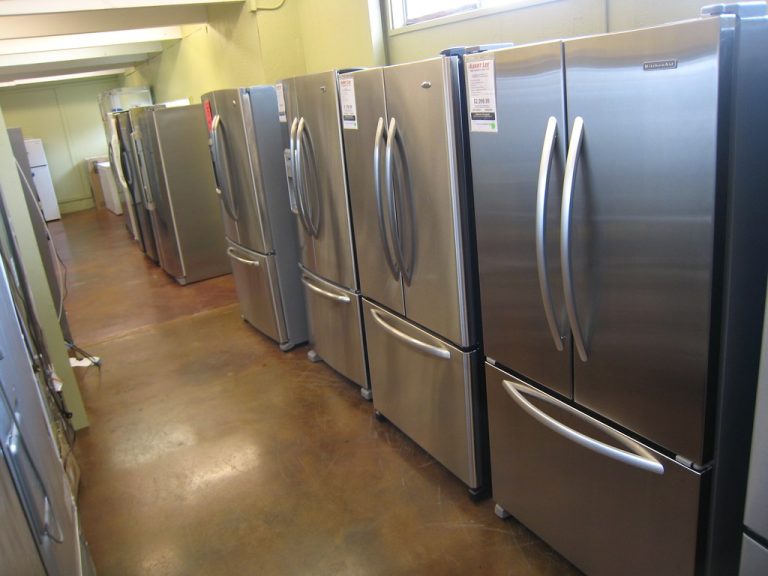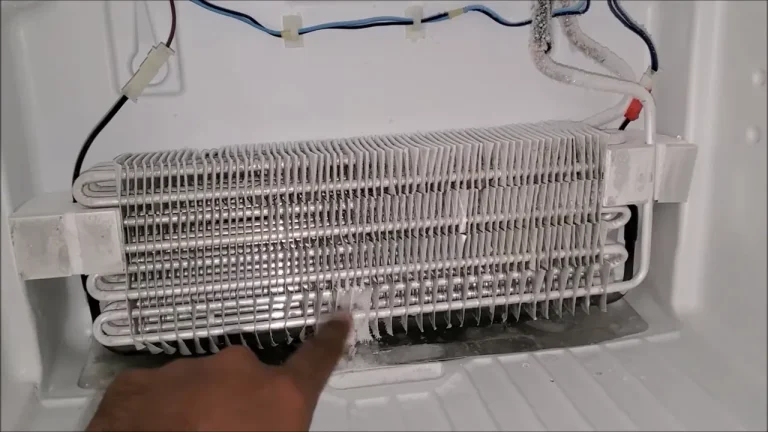My Samsung Ice Maker Not Working But Water Does! (Reasons & Fix)
If your Samsung ice maker is not working while the water dispenser functions properly, several potential issues may be causing this problem. First, check if the ice maker is turned on and verify that the ice maker arm is in the down position. Ensure that the water supply is connected and the water line is not frozen. Additionally, inspect the water inlet valve for any blockages.
Why Samsung Ice Maker Not Working But Water Does?
1. Your Water Line Might Be Ice-Blocked
If your Samsung ice maker is not working, and the water dispenser is functioning correctly, a possible cause is a blocked water line. The water line supplying the ice maker may be frozen. To fix this issue, follow these steps:
- Locate the Water Line: Identify the water line that supplies water to the ice maker. Typically, it is located at the back of the refrigerator.
- Check for Blockages: Inspect the water line for any visible ice blockages. If you notice any, carefully thaw the ice by using a hair dryer on a low setting or by placing warm towels around the affected area.
- Adjust the Temperature: Ensure that the freezer is set to the recommended temperature, usually around 0 degrees Fahrenheit (-18 degrees Celsius). Adjust the temperature if needed to prevent future ice blockages.
- Inspect the Water Filter: If your refrigerator has a water filter, check its condition. A clogged or expired filter can impede water flow. Replace the filter if necessary.
- Run the Ice Maker: Once you have cleared any ice blockages and made necessary adjustments, turn the ice maker back on. Allow some time for the ice production to resume.
- Monitor Performance: Keep an eye on the ice maker’s performance over the next few hours. If the issue persists, consider consulting the user manual or contacting Samsung customer support for further assistance.
2. Your Ice Maker Assembly Might Be Failing
If your Samsung ice maker is not working, and the water dispenser is operational, a potential cause could be a failing ice maker assembly. To address this issue, follow these steps:
- Inspect Ice Maker Components: Open the freezer compartment and examine the ice maker assembly. Check for any visible damage or misalignment of components.
- Reset the Ice Maker: Some Samsung refrigerators have a reset button on the ice maker. Locate this button and press it to reset the ice maker. Refer to your refrigerator’s manual for specific instructions on resetting the ice maker.
- Power Cycle the Refrigerator: Turn off the power to your refrigerator for about 30 seconds and then turn it back on. This can sometimes reset the ice maker and resolve issues with its operation.
- Check for Ice Obstructions: Ensure that there are no obstructions or ice buildup within the ice maker itself. Clear any ice that might be blocking the movement of the ice maker components.
- Verify Water Supply: Confirm that the water supply to the ice maker is adequate. Ensure that the water line is not kinked or obstructed, and the water inlet valve is functioning correctly.
- Temperature Settings: Ensure that the freezer is set to the recommended temperature for ice production, usually around 0 degrees Fahrenheit (-18 degrees Celsius).
3. The Auger Motor Might Be Faulty
If your Samsung ice maker is not working, and water is dispensing correctly, a possible culprit could be a faulty auger motor. The auger motor is responsible for turning the auger, which dispenses ice from the ice bin. To address this issue, follow these steps:
- Check for Obstructions: Inspect the ice bin and auger assembly for any obstructions, such as ice jams or foreign objects. Clear any blockages that may be preventing the auger from turning freely.
- Test Auger Motor: Activate the ice dispenser, and listen for any humming or clicking sounds near the ice maker. If you don’t hear any noise, it may indicate a problem with the auger motor.
- Reset the Motor: Some models may have a reset button on the ice maker or dispenser. Refer to your refrigerator’s manual to locate and press the reset button. This can sometimes resolve issues with a stalled or malfunctioning motor.
- Inspect Motor Connections: Ensure that the auger motor is securely connected. Loose or damaged wiring can affect the motor’s performance. If you find any issues, consider repairing or replacing the affected components.
- Power Cycle the Refrigerator: Turn off the power to your refrigerator for about 30 seconds and then turn it back on. This can help reset electronic components, including the auger motor.

4. Your Freezer Temperature Might Be Above 100F
If your Samsung ice maker is not working and water is dispensing correctly, a possible reason might be that the freezer temperature is too high. Ice makers typically operate efficiently when the freezer temperature is set at or below 0 degrees Fahrenheit (-18 degrees Celsius). Here’s how you can fix this issue:
- Check Freezer Temperature: Verify the current temperature setting of your freezer. Use a freezer thermometer to ensure that the temperature is at or below 0 degrees Fahrenheit (-18 degrees Celsius). Adjust the thermostat if necessary.
- Allow Time for Cooling: After adjusting the temperature, give the freezer some time to reach the desired setting. It may take a few hours for the temperature to stabilize.
- Check for Ventilation Issues: Ensure that the vents inside the freezer are not blocked by food items, preventing proper airflow. Adequate ventilation is crucial for maintaining a consistent and low temperature.
- Inspect Door Seals: Check the integrity of the freezer door seals. Damaged or worn seals can allow warm air to enter, affecting the overall temperature. Replace any faulty seals to improve insulation.
- Remove Ice Buildup: If there is excessive ice buildup within the freezer, it can hinder proper cooling. Defrost the freezer and remove any accumulated ice to promote efficient temperature regulation.
- Avoid Overloading the Freezer: Overloading the freezer with a large quantity of warm items can temporarily raise the temperature. Allow space for proper air circulation and avoid placing hot or warm items directly into the freezer.
- Verify Power Supply: Ensure a stable power supply to the refrigerator. Fluctuations or power outages can impact the cooling efficiency. Use a surge protector if needed.
5. Your Water Inlet Valve Might Be Defective
If your Samsung ice maker is not working, and the water dispenser functions correctly, a defective water inlet valve could be the culprit. The water inlet valve is responsible for supplying water to the ice maker. To address this issue, follow these steps:
Inspect Water Inlet Valve: Locate the water inlet valve, usually located at the back of the refrigerator. Check for any visible signs of damage or leaks. If the valve appears damaged or is leaking, it may need to be replaced.
Check Water Supply: Ensure that the water supply to the refrigerator is turned on and that there are no kinks or blockages in the water line. Adequate water flow is crucial for the proper functioning of the water inlet valve.
Test the Valve Solenoid: Use a multimeter to test the solenoid of the water inlet valve for continuity. If the solenoid does not show continuity, it indicates a defective valve. In this case, replacing the water inlet valve is necessary.
Replace the Water Inlet Valve: If the water inlet valve is found to be defective, replace it with a compatible replacement part. Refer to your refrigerator’s manual or seek guidance from Samsung customer support for information on obtaining the correct replacement valve.
6. The Water Pressure to The Inlet Valve Might Be Lower Than 20 PSI
If your Samsung ice maker is not working, and the water dispenser is functional, insufficient water pressure to the inlet valve could be the issue. The water pressure should be at least 20 PSI (pounds per square inch) for proper ice maker operation. Here’s how to fix this problem:
Check Water Pressure: Use a water pressure gauge to measure the water pressure at the connection point to the refrigerator. Ensure that the pressure is at least 20 PSI. If it is below this threshold, you will need to address the low water pressure.
Inspect Water Supply Line: Examine the water supply line for any kinks, bends, or obstructions. Straighten out kinks and clear any blockages to ensure a smooth water flow.
Adjust Water Supply Valve: If the water supply valve connected to the refrigerator is not fully open, turn it counterclockwise to increase the water flow. Ensure that the valve is fully open to allow sufficient water pressure.
Replace or Upgrade Water Supply Line: If you have an old or kinked water supply line, consider replacing it with a newer, more flexible one. Upgrading to a higher-quality line can help maintain consistent water pressure.
Check External Water Filter: If your refrigerator has an external water filter, check its condition. A clogged or expired filter can restrict water flow. Replace the filter if necessary.
Verify Inlet Valve Functionality: Confirm that the water inlet valve is working correctly. Inspect it for any visible damage or leaks. If the valve is damaged, it may need to be replaced.

7. The Ice Maker Could Be Off
If your Samsung ice maker is not working and the water dispenser is functioning correctly, it’s possible that the ice maker itself is turned off. Here’s how to fix this issue:
- Check Ice Maker Status: Locate the ice maker control or switch inside the freezer. It is usually found on the side or front of the ice maker unit.
- Turn On the Ice Maker: If the ice maker is in the “Off” position, switch it to the “On” position. This simple step can often resolve the issue.
- Wait for Ice Production: After turning the ice maker on, wait for some time, typically a few hours, to allow the ice maker to start producing ice. It may take some time for the ice-making process to begin.
- Confirm Power Supply: Ensure that the refrigerator is receiving a stable power supply. A power outage or electrical issues can disrupt the ice maker’s operation.
- Check for Ice Jam: Inspect the ice maker for any visible signs of ice jams or blockages. Clear any ice that may be obstructing the movement of the ice maker components.
- Temperature Settings: Confirm that the freezer is set to the recommended temperature for ice production, usually around 0 degrees Fahrenheit (-18 degrees Celsius).
Why does my Samsung dispense water but not ice?
If your Samsung refrigerator is dispensing water but not producing ice, there are several potential reasons for this issue. One common cause is a problem with the ice maker components. Check if the ice maker is turned on and inspect the ice maker assembly for any visible signs of damage or misalignment. Additionally, ensure that the freezer is set to the recommended temperature for ice production, usually around 0 degrees Fahrenheit (-18 degrees Celsius).
Another possible reason is a blocked or frozen water line supplying the ice maker. Check the water line for any obstructions, and if necessary, thaw out any ice blocking the line. Verify that the water inlet valve is functioning correctly and that there is sufficient water pressure (at least 20 PSI) for proper ice maker operation.
If these basic checks do not resolve the issue, it could be related to a faulty water inlet valve, a malfunctioning auger motor, or even problems with electronic components.
Why is my ice maker not making ice but the water works?
If your ice maker is not producing ice while the water dispenser is functioning properly, there are several potential reasons for this issue. First, check if the ice maker is turned on and the ice maker arm is in the down position. Verify that the freezer is set to the recommended temperature for ice production, typically around 0 degrees Fahrenheit (-18 degrees Celsius).
A common problem could be a blocked or frozen water line leading to the ice maker. Examine the water line for any obstructions, and if necessary, thaw out any ice causing the blockage. Ensure the water inlet valve is operational, and there is sufficient water pressure (at least 20 PSI) reaching the ice maker.
Additionally, inspect the ice maker components for any visible damage or misalignment. Reset the ice maker if there’s a reset button, and allow some time for the ice-making process to resume.

Why is my ice maker giving water instead of ice?
If your ice maker is dispensing water instead of producing ice, there may be a few reasons behind this issue. One possibility is a malfunction in the ice maker’s control system or electronic components. Check if the ice maker is in the correct mode for ice production, and ensure that there are no error codes or indicators suggesting a problem.
Another potential cause could be a faulty water inlet valve. The water inlet valve controls the flow of water to both the ice maker and the water dispenser. If it’s malfunctioning or stuck open, it can lead to water being dispensed instead of ice. Inspect the valve for visible damage or leaks, and consider testing its functionality using a multimeter.
Additionally, check the ice maker’s internal components, such as the ice maker assembly and auger motor, for any visible damage or misalignment. Resetting the ice maker or performing a power cycle on the refrigerator might also help resolve certain electronic glitches.
How do you reset your Samsung ice maker?
The process to reset a Samsung ice maker can vary depending on the model of your refrigerator. However, here is a general guide that may help you reset your Samsung ice maker:
- Locate the Reset Button or Switch: Many Samsung refrigerators with ice makers have a reset button or switch. Check your refrigerator’s user manual or look for the reset button on the ice maker itself. The button is often located on the front of the ice maker or inside the ice maker compartment.
- Press and Hold the Reset Button: If your ice maker has a reset button, press and hold it for about 10 seconds. This action should initiate the reset process.
- Wait for Confirmation: After holding the reset button, wait for the ice maker to make a sound or for any indicator lights to change, signaling that the reset is complete.
- Power Cycle the Refrigerator: As an additional step, you can turn off the power to your refrigerator for about 30 seconds and then turn it back on. This can help reset the electronic components, including the ice maker.
- Check the User Manual: If you can’t find a reset button or if the above steps don’t apply to your specific model, refer to your refrigerator’s user manual for detailed instructions on resetting the ice maker.
FAQ:
1. Why is my Samsung ice maker not producing ice while the water dispenser works?
Possible reasons could include issues with the ice maker assembly, water inlet valve, or temperature settings. Troubleshoot by checking these components for malfunctions.
2. What should I do if my ice maker is turned on, but it’s not making ice?
Verify that the ice maker is on, inspect for any visible damage, and ensure the freezer is set to the recommended temperature for ice production (around 0°F or -18°C).
3. Why does my ice maker dispense water instead of ice cubes?
A malfunctioning water inlet valve or a problem with the ice maker’s electronic components could lead to this issue. Consider checking and resetting the ice maker as needed.
4. How can I determine if the water inlet valve is causing the ice maker problem?
Inspect the water inlet valve for visible damage or leaks. Test the valve’s functionality using a multimeter. A defective valve may need replacement.
5. Is low water pressure a common cause for the ice maker not working?
Yes, low water pressure (below 20 PSI) can affect ice production. Ensure proper water pressure and inspect the water supply line for any obstructions.
6. What role does the freezer temperature play in ice maker functionality?
The freezer should be set to the recommended temperature to ensure optimal ice production. Adjust the thermostat if needed, and allow time for the temperature to stabilize.
7. How do I reset my Samsung ice maker?
Locate the reset button on the ice maker and press and hold it for about 10 seconds. Alternatively, power cycle the refrigerator by turning it off for 30 seconds and then back on.
8. What are common issues with the ice maker assembly that could affect ice production?
Inspect the ice maker assembly for visible damage or misalignment. Reset the ice maker and check for any ice jams or blockages within the assembly.
9. Can a clogged water filter impact the ice maker’s performance?
Yes, a clogged or expired water filter can restrict water flow to the ice maker. Consider replacing the water filter if necessary.
10. When should I seek professional help for my Samsung ice maker issues?
If troubleshooting steps do not resolve the problem or if you are unsure about diagnosing and fixing the issue, it’s advisable to contact Samsung customer support or a certified technician for assistance.
As an Amazon Associate I earn from qualifying purchases.
- Can You Put Clouds Shoes in the Washing Machine? With Tips & Tricks - April 10, 2024
- European Washing Machine vs American – History, Design, Technology - March 27, 2024
- Can You Put Boxing Gloves In The Washing Machine? – Expert Tips - March 25, 2024


![Bosch vs LG Refrigerator [Which One Should You Choose?]](https://homeplacetips.com/wp-content/uploads/2023/10/Bosch-Maxflex-332L-Refrigerator-🇮🇳-Best-Refrigerator-2023-⚡️-Best-3-Door-Refrigerator-2023_000056394-768x432.webp)

![Samsung Fridge Water Dispenser Keeps Running [Quick Fixes]](https://homeplacetips.com/wp-content/uploads/2023/10/Samsung-Fridge-Water-Dispenser-Keeps-Running-768x513.jpeg)


![Whirlpool Refrigerator Water Dispenser Not Working After Replacing Filter [2024]](https://homeplacetips.com/wp-content/uploads/2023/12/Refrigerators-You-Should-Never-Buy_000098922-768x432.webp)